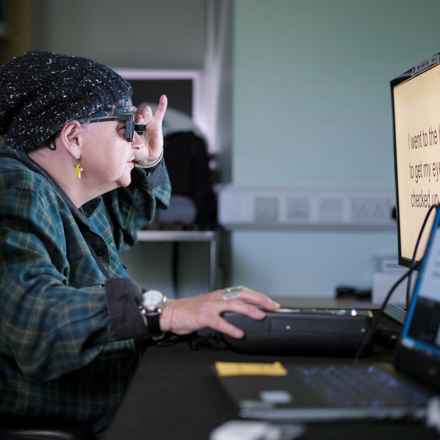Revolutionary implant allows patients with dry AMD to read again
Posted: Monday 20 October 2025
A revolutionary new implant has restored some vision to patients with dry age-related macular degeneration (AMD), enabling them to read words and numbers, boosting hopes of a breakthrough treatment.
The PRIMA System, hailed as the first implantable device to enable people to read using an eye that had lost sight, works with a specialised set of glasses which convert light into signals that healthy retinal cells can send to the brain.
Five patients underwent surgery to receive the PRIMA implant as part of a clinical trial at Moorfields Eye Hospital in London, with 38 patients taking part in the study across five other European countries. These patients had no central vision before taking part, however 84.4% of those on the trial regained the ability to read letters, numbers, and words.
On average, patients were able to read up to five lines on an eye chart, thanks to the PRIMA System.
“I was an avid bookworm and I wanted that back”
Moorfields patient Sheila Irvine took part in the trial after speaking to her optician. Despite still living an active life, she was keen to take part in research if not to aid herself, but to help find a breakthrough for others.
“Before receiving the implant, it was like having two black discs in my eyes, with the outside distorted,” she said.
“I was an avid bookworm, and I wanted that back. I was nervous, excited, all those things. There was no pain during the operation, but you’re still aware of what’s happening.
“It’s a new way of looking through your eyes, and it was dead exciting when I began seeing a letter. It’s not simple, learning to read again, but the more hours I put in, the more I pick up.
“The team at Moorfields has given me challenges, like ‘look at your prescription’, which is always tiny. I like stretching myself, trying to look at the little writing on tins, doing crosswords.
“It’s made a big difference. Reading takes you into another world, I’m definitely more optimistic now.”
What is the PRIMA System?
The PRIMA System consists of three elements; a wireless retinal implant just 2mmx2mm in size which is inserted under the patient's retina, a pair of augmented-reality glasses with a camera and digital projector, and a pocket processor.
A month after surgery, giving time for the eye to settle, the implant chip is activated to capture the visual scene projected by the glasses and transmits this to the computer. Artificial intelligence (AI) algorithms process this information and instruct the glasses to focus on what it perceives to be the main object in the image. The glasses project this image as an infra-red beam through the eye to the chip, which converts this into an electrical signal. This signal passes through the retina cells and optical cells into the brain, where it is interpreted as if it were natural vision.
“A new era” for artificial vision
Mahi Muqit, senior vitreoretinal consultant at Moorfields Eye Hospital and the Institute of Ophthalmology at UCL, said: “In the history of artificial vision, this represents a new era. Blind patients are actually able to have meaningful central vision restoration, which has never been done before.
“Getting back the ability to read is a major improvement in their quality of life, lifts their mood and helps to restore their confidence and independence.
“The PRIMA chip operation can safely be performed by any trained vitreoretinal surgeon in under two hours - that is key for allowing all blind patients to have access to this new medical therapy for GA (geographic atrophy) in dry AMD.”
“Great potential” – Dr Peter Bloomfield
Welcoming the PRIMA System results, director of research at the Macular Society Dr Peter Bloomfield said: “These are encouraging results which indicate an improved quality of life to patients living with dry AMD, particularly GA. Where there is currently no treatment option, this is fantastic news.
“Artificial vision may offer a lot of hope to many, particularly after previous disappointments in the world of dry AMD treatment. The interface between digital and biological systems offers great potential and this is exciting news.
“We are now watching closely to see if the PRIMA System will be approved for use here in the UK, and crucially whether it could be made available on the NHS. Regardless, we will continue to offer support to people and fund more research to help everyone affected by macular disease.”
The PRIMA System was originally developed by Pixium Vision. In 2022, an 88-year-old woman became the first UK patient to receive the device, as part of the trial at the time. The PRIMA System is now being developed by California-based Science Corporation.
Anyone interested in the device for themselves is advised to visit the Moorfields website.
Q&A - your questions answered on the PRIMA System clinical trial for dry AMD
All you need to know following the published results of Science Corporation's clinical trial to treat patients with late-stage dry age-related macular degeneration (AMD).
Get involved in research
Patients have a very important part to play in medical research. Without them we would not have the treatments we have today and new and improved treatments would not be possible.




